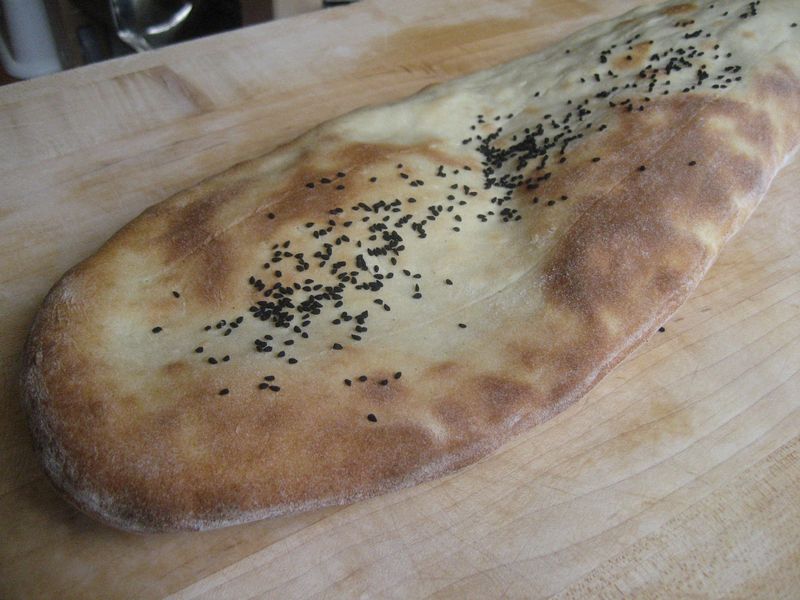By Humaira
Two years ago I took Katie on a tour of “Little Kabul”, the Afghan district of Fremont located about an hour outside of San Francisco that stretches all of three blocks. I saved the best for last and finished up the outing with a visit to Maiwand Market, a bustling Afghan grocery store and bakery. The market is one of the largest producers of Afghan nan in the Bay Area, churning out over 2,000 loaves a day. Despite the fact we were stuffed with kebabs, the smell of the bread was irresistible and we couldn’t walk away empty handed. The question was: one loaf or two? The loaves measure a couple of feet long. We spent five minutes contemplating whether we could eat that much nan? Would it be wasted? Do we have room in our freezers? As we went back and forth an Afghan lady walked up, ordered 20 loaves, and walked off, cradling her armful of bread. Without missing a beat, we quickly settled on two loaves and left.
Afghans eat a lot of nan:with every meal, with or without rice. Every Afghan village and every neighborhood in Kabul has a bakery (nanwayee) outfitted with a clay oven (tandoor) built into the earth. The tandoor is round with a big opening and runs about five feet deep. Most home cooks prepare their own dough and bring it to the tandoor, which is kept piping hot all day. The bread baker takes the dough, forms it into a long oval shape measuring about three feet long and a half- inch thick and using a paddle covered with thick wet cloth, presses the dough onto the searing hot wall of the tandoor. The humidity and high heat bakes the bread in minutes and gives it a delicious flavor. The bakery charges the family by making a notch in a stick for every piece that is baked. The family pays at the end of the week based on how many notches are in the stick. Nan tastes best right from the oven.
If you don’t happen to live in Fremont or Afghanistan you can still enjoy nan by making it in your home oven. Traditional nan is made using a starter (khamir toursh) but this recipe uses packet yeast. The secret is a super hot oven and the right amount of humidity. Get the oven piping hot and have a water spray bottle around for moisture. I cobbled together the recipe using tips from my mom, Afghan author Tamim Ansary, my baker friend Mari and Helen Saberi’s book Afghan Food & Cookery. My daughter Aria, an Afghan bread connoisseur, declared the results, “yummy!”. Your nan will not look like the one from Maiwand Market but it will hopefully be yummy too!
Afghan Flat Bread
Nan
5 cups bread flour
2 tsp. Kosher salt
1 packet quick rising yeast
5 tsp. vegetable oil
2 cups warm water
1 tsp Nigella seeds (optional)
1 spray bottle filled with water
Put the flour, salt and yeast in the bowl of a food processor fitted with a dough blade. Process it for a few seconds to mix the ingredients. Continue to process as you dribble the oil into the flour. Next, slowly add the water to the flour with the processor running.If the mixture sticks to the sides of the processor, scrape it down and process some more. After a few minutes, the dough will come together in one smooth lump and it will move around the food processor. Let is swirl a couple of time and then it’s ready to rest.
If you don’t have a food processor, you can make the bread by hand. Pour all the dry ingredients in a big bowl and mix well. Add oil and mix further. Gradually add the water and knead the dough for 10 to 15 minutes the dough is smooth and elastic. Once the dough is done, set it in a large bowl, cover with 2 dish cloths and keep in a warm place for 2 hours. Punch down the dough. It is ready to be baked.
Preheat oven to 500 degrees. If you have convection, turn it on. Cover a large baking sheet with aluminum foil and set in the oven to heat. Spread some flour on the work surface and pat your hands with flour to keep the dough from sticking to your hands. Divide the dough into three balls and work it gently into an oval that measures about 1 ½ feet long and ½- inch thick. As you stretch the dough it will pick up some of the flour from the work surface, make sure that you add more flour or the dough will stick to the work surface. Once the dough is shaped make three deep lines (don’t cut the dough) lengthwise on the surface of the dough with a knife.
Once the oven is very hot, remove the baking sheet. Gently lay the shaped dough onto the baking pan and sprinkle with nigella seeds. Gently press the seeds into the dough. Place the dough in the oven, spray 5-6 times with your spray bottle and bake for 5 minutes. After 5 minutes, spray the bread around 5-6 times and continue to bake for another 5 minutes. The nan should be golden brown and crusty on the outside.
To keep the bread moist, wrap the warm bread in a large dishcloth until it cools down. Be sure to taste it while it is still warm. Cut in into 3-inch squares. Store in a Ziploc bag and place in the fridge. Reheat it in the toaster oven and enjoy it with feta cheese and a dab of cherry jam along with a cup of tea.
Ready for the oven.
Ready to eat
Except where otherwise noted, all content on this blog is licensed under the Creative Commons Attribution-NonCommercial-NoDerivs 3.0 Unported license.





